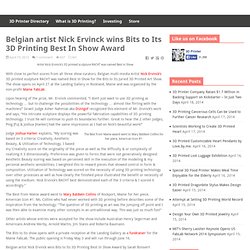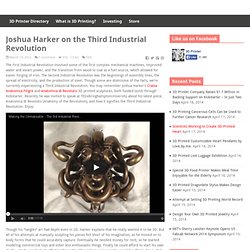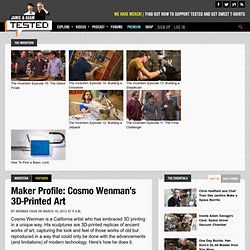

Personal Creations. Nick Ervinck. With close to perfect scores from all three show curators, Belgian multi-media Artist Nick Ervinck’s 3D printed sculpture RACHT was named Best in Show for the Bits to Its Juried 3D Printed Art Show.

The show opens on April 27 at the Landing Gallery in Rockland, Maine and was organized by the non-profit Maine FabLab. Upon hearing of the prize, Mr. Ervinck commented, “I don’t just want to use 3D printing as technology … but to challenge the possibilities of the technology … almost like flirting with the machines!” Israeli Judge Asher Nahmias aka Dizingof recognized this element of Mr. Ervinck’s work and says, “His intricate sculpture displays the powerful fabrication capabilities of 3D printing technology. Judge Joshua Harker explains, “My scoring was based on 3 criteria: Creativity, Aesthetic Beauty, & Utilization of Technology. The Best from Maine award went to Mary Baldwin Collins of Rockport, Maine for her piece, American Icon #1.
Related. Joshua Harker. The First Industrial Revolution involved some of the first complex mechanical machines, improved water and steam power, and the transition from wood to coal as a fuel source, which allowed for easier forging of iron.

The Second Industrial Revolution was the beginnings of assembly lines, the spread of electricity, and the production of steel. Though some are dismissive of the facts, we’re currently experiencing a Third Industrial Revolution. You may remember Joshua Harker’s Crania Anatomica Filigre and Anatomica di Revolutis 3D printed sculptures, both funded (sold) through Kickstarter. Recently he was invited to speak at TEDxBringhamptonUniversity about his latest piece, Anatomica di Revolutis (Anatomy of the Revolution), and how it signifies the Third Industrial Revolution. Enjoy: Though his “tangles” art had depth even in 2D, Harker explains that he really wanted it to be 3D. To get the rest of the story behind Anatomica di Revolutis you’re going to have to watch the video.
Related. Bathsheba Grossman. Shane Hope. Species-Tool-Being No. 5, 2012. 3D-printed PLA molecular models on acrylic substrate. 12"x12" Artist Shane Hope creates incredibly intricate works by merging two cutting edge technologies: 3D printing and molecular nanotechnology.

“Species-Tool-Being No. 5″ 2012. 3D-printed PLA molecular models on acrylic substrate. 12″x12″. (detail) Using advanced molecular modeling software, Hope designs new and abstracted “nano-scaled structures” on a computer. He then prints thousands of these models on a RepRap (an open-source, build-it-yourself, self-replicating 3D printer) in a vast range of colors and transparencies and finally collages them together in dynamic and well-considered compositions. “Smartdustormin’”, 2013. 3D-printed PLA molecular models on acrylic substrate. 24″x24″ “Smartdustormin’” (detail with penny for scale) “Species-Tool-Being No. 6″, 2012. 3D-printed PLA molecular models on acrylic substrate. 12″x12″ “Species-Tool-Being No. 6″ (detail with LifeSaver for scale)
John Dreyfuss. Cosmo Wenman. Today's desktop 3D printers are more comparable to dot-matrix printers than high-dpi laser printers; there's a lot of room for improvement in the nascent but fast-growing technology.

It's easy to imagine where that technology is headed: finer resolution printing, faster print heads, different materials, multiple colors. But that doesn't mean that the 3D-printed objects of today can't be more than disposable prototypes and knick knacks. It doesn't mean they can't be beautiful works of art. Cosmo Wenman is a California artist who has embraced 3D printing in a unique way. His sculptures are 3D-printed replicas of ancient works of art, capturing the look and feel of those works of old but reproduced in a way that could only be done with the advancements (and limitations) of modern technology.
We met Cosmo at this year's CES, where his work had returned from the 2012 London 3D printshow and was on display at the MakerBot booth. Let's start with your background. Photo Credit: Cosmo Wenman.